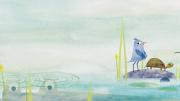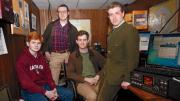The legendary explorer was at home behind the camera.
Barging on the seine this summer? Don't forget your plant-hunting gear and your Sanderson field camera, cumbersome tripod, and crates of 6 1/2-by -8 1/2-inch glass-plate negatives. Thus equipped, you may be mistaken for Ernest Henry "Chinese" Wilson.
Wilson was born in Chipping Campden, England, in 1876. In 1899 Veitch Nurseries sent him to China to find seeds of the handkerchief or dove tree, Davidia involucrata. Wilson returned in 1902. The prize was in hand, as well as 400 other plants new to cultivation in the West.
Back Veitch sent him in 1903 to find a yellow poppy, Meconopsis integrifolia, a plant known in the West only as a dried herbarium specimen. He found it, along with many new rhododendrons, roses, primulas--a cornucopia of exotic plants.
Harvard's Arnold Arboretum stole Wilson away and sent him on two more expeditions to China, and then to Japan, Korea, and elsewhere in the East. Among his more popular discoveries are the paperbark maple, with exfoliating bark the color of cinnamon; the Korean version of Stewartia pseudocamellia, with flowers like single, white camellias; the flamboyant hardy silk tree, festooned with pink powderpuffs; and the regal lily, raising white trumpets. He was once estimated to have gathered 2,000 new species in a four-month period. Many of his original plants may be seen today at the arboretum. They are treasures certainly, but a treasure, too, is the ar-boretum's collection of 5,000 of Wilson's glass negatives.
  |
| The color photographs show plants introduced into Western gardens by Wilson. Color photographs by Peter Del Tredici |
Charles Sprague Sargent, then director of the arboretum (Wilson would succeed him), insisted that Wilson pack a camera on his journeys. Although he "professed ignorance of the art of photography," as former arboretum horticultural taxonomist Stephen A. Spongberg relates in A Reunion of Trees, Wilson complied. He was to photograph plant life, but, Sargent admonished, "It would be well, too, if time permits, to take views of villages and other striking and interesting objects as the world knows little of the appearance of central and western China."
 |
| Wilson photograph courtesy of the Arnold Arboretum |
Many of Wilson's photographs qualify as fine art. Some are merely interesting, as the one above, showing a houseboat he bought at Yichang in 1907 for travel on the Jinsha Jiang (Yangtze) in Hubei and Sichuan. Wilson's "boy" and the captain stand on the cabin roof; the expedition's handyman is on the gangplank. Wilson christened the good ship The Harvard.





